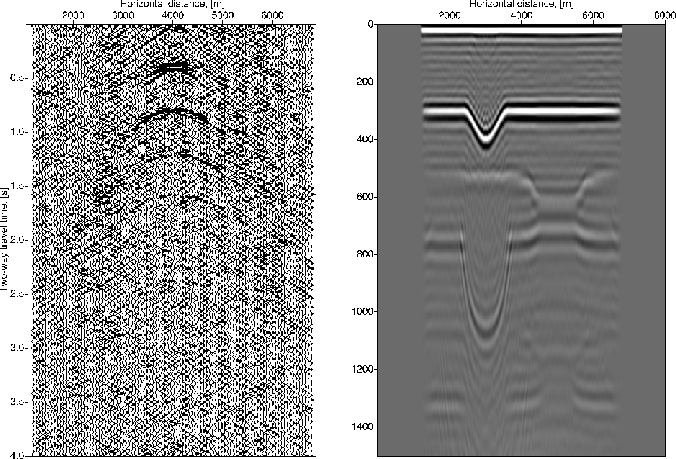




Next: Conclusions
Up: Artman et al.: Migration
Previous: Direct migration of white-noise
In this section, we present some numerical results showing the
behavior of the simulated reflection shot gathers and the migrated
image when changing some source and receiver parameters. The
migrations were performed with the exact velocity model. No multiple
elimination schemes were applied.
The quality of the end result depends strongly on the number of the
present subsurface sources. The left panels from Figures 3
through 6 show simulated reflection shot gathers
for a decreasing number of subsurface noise sources with a simulated
surface shot position at x1=4000 m. The right panels from Figures
3 through 6 show the results from
direct migration of the same noise recordings. The noise recordings
were 6 minutes long. We see that the simulated reflection responses
very quickly decrease in quality (compared with the directly modelled
reflection response in Figure 11), while the migration
process delivers much better results. Fewer source locations cause
illumination problems in the migration result.
dx_50m
Figure 2 Left: Simulated reflection shot panel from 6 minutes long
noise recordings with 113 regularly distributed subsurface sources
with a simulated shot position at x1=4000 m. Right: Result from
direct migration of 6 minutes long noise recordings with 113
regularly distributed subsurface sources.

The left panels of Figures 7 through 10 show the
change in quality of the simulated reflection shot gather (with
simulated surface shot position at x1=4000 m) when decreasing the
recording time length of the receivers. The right panels of Figures 7
through 10 show the migrated image for the same noise
recordings. We can see that while for short recording times the
quality of the simulated reflection is strongly degraded, the result
from migration is still good, only the signal-to-noise ratio has
decreased. Note that multiple events that are hardly visible in the
simulated reflection shot gathers at short recording times are still
clearly present in the migrated image.





Next: Conclusions
Up: Artman et al.: Migration
Previous: Direct migration of white-noise
Stanford Exploration Project
5/23/2004
